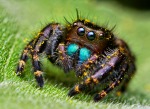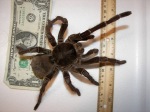- 1 Million Spiders Make Golden Silk for Rare Cloth
- There is a gentle spider that eats vegetables and cares for its kids
- 3D Imaging Technique Brings 50 Million-Year-Old Spider to Glorious, Gory Life
Spider Awards
Largest spider
The award for the most astronomically sized arachnid goes to the Goliath Bird-eating Tarantula (Theraphosa blondi), who lives in the rain forests of northern South America and grows up to a whopping 12 inches across, including legs. Females can live up to 25 years and can weigh nearly a half a pound.
Although this giant is called the Bird-eater, named by Victorian explorers who witnessed the spider devouring a hummingbird, the tarantula doesn’t have particular preference for birds. Like other spiders, the Goliath’s favorite foods are small insects such as crickets and beetles. However, he’s also an opportunistic eater: When faced with a delectable reptile, bird or small mammal, what’s a hungry spider to do? Apparently, the Goliath will gobble up just about anything that’s smaller than itself.
Smallest Spider
Unfortunately, these micro-spiders are so tiny that no one seems to have taken decent photographs of them. The little guy pictured above, called an Assassin spider, is slightly bigger than the Patu or the Anapistula, but at less than an eighth of an inch, he still ranks as one of the tiniest arachnids around. And with his impressive jaws and oddly elongated neck used to catch prey from a distance, we think he’ll do just fine to represent his ilk in our Hall of Fame.
 Snobbiest Spider
Snobbiest Spider
Winner of the show-off category, the male peacock spider (Maratus volans) uses its brightly colored stripes to impress and attract special lady friends. During a mating display, the male raises its colorful abdomen and waves it like a peacock displaying its feathers. The spider also picks up his third pair of legs and vibrates them slightly, dancing from side to side in what looks a bit like the arachnid Macarena. Despite its larger-than-life display, the peacock spider is actually quite tiny, with a body only about 0.2 inches in diameter. A variety of jumping spider, these ostentatious arachnids are found only in certain parts of Australia. 
This spiny-backed orb-weaver (Gasteracantha cancriformis) clearly merits his prize. Found throughout the southern United States and in parts of South America, the odd-looking arachnid can be easily identified by its peculiar oblong shape and distinctive black markings.
Found in warm, damp regions of Brazil, northern Argentina and Uruguay, the wandering spider carries a potent neurotoxin that causes loss of muscle control, breathing problems and severe pain. In addition, Phoneutria venom has a peculiar effect on its male victims, causing painful erections that can last for several hours and lead to impotence. In fact, scientists have recently started studying potential uses of the venom, called Tx2-6, for erectile dysfunction.
Of all the eight-legged critters you don’t want to run into, the Brazilian wandering spider (Phoneutria nigriventer) might be the most deadly. Dubbed the “Most Venomous Spider” in the 2007 Guinness Book of World Records, this formidable arachnid is thought to be responsible for more human deaths than any other spider.
Among arachnophiles, there’s a bit of controversy over who should win the award for the world’s smallest spider. Some sources say the prize should go to the male Patu digua of Colombia, whose tiny body grows to just 0.015 inches and could easily fit on the head of a pin. But there may be even smaller spiders out there: The female Anapistula caecula of West Africa measures just three one-hundredths of an inch larger than the male Patu, but her male counterpart has never been spotted. Presumably, because male spiders are nearly always smaller than females of the same species, the true winner of our award should be the yet-undiscovered male Anapistula.

Cuddliest/ Pet spider
Cuddliest Spider
We’ve covered giant spiders, deadly spiders and even stuck-up spiders. But what if you want to keep a spider as a pet? According to various spider-care experts, one of the best eight-legged friends for a new arachnid enthusiast is the Chilean Rose Spider (Grammostola rosea), a medium-sized tarantula that’s “attractive, hardy and comparatively easy to care for,” according to tarantulas.com
Inexpensive and readily available at a pet store, these little guys are also relatively docile and don’t usually bite unless they feel threatened.On occasion, however, these tarantulas can spell trouble. Some individuals stay put in their cage, even earning the nickname of “pet rock” spiders, but others have a tendency to repeatedly escape and wander off. But beware: Unsuspecting first-time owners may unknowingly buy a mature male instead of a young female. While the girls can live 10 to 15 years, boy spiders live only a few months after maturity, and don’t make a good investment.

With her big beady eyes and shimmery turquoise fangs, this juvenile jumping spider (Phidippus audax) takes the award for cutest arachnid in our Hall of Fame. Based on the bright yellow pollen dusting her furry coat, it also looks like she may have had a recent run-in with a wildflower. More than 5,000 species of jumping spiders, or Salticidae, have been identified around the world, and they can be easily distinguished from other types of spiders by the four big eyes on the front of their face and the four smaller eyes on top of their head. These impressive acrobats get their name from the fact they can jump more than 50 times their body length.




